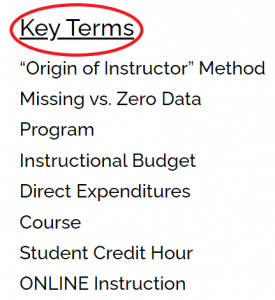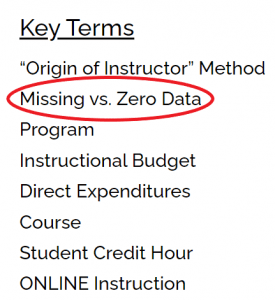
THE COST STUDY DATA DICTIONARY
Click here to download an interactive pdf of the data dictionary
(edited 8/10/23)
REVISION HISTORY
8/10/23: Release of 2023 Data Dictionary
- Updates to all relevant dates
- New and discontinued data fields
- New – College/School variable: To improve our new dashboard reporting tools, we have created a new (optional) variable for the 2023 cycle that collects the name of the college, school, or unit for each program that you submit to the study. These codes will not be used to calculate any benchmark metrics and will only be used to sort your programs into groupings on our new institution dashboard.
- Discontinued – Optional Covid-19 ONLINE SCH: In response to the massive shift to online instruction as a result of the Covid-19 pandemic, the study included four additional optional online fields in the 2021 and 2022 cycles. Activity captured for these values only included courses that were originally scheduled to be taught online, and they would have been taught online regardless of the constraints of the pandemic. Because these fields are no longer relevant to our analyses of online instruction, they have been removed from the data entry form for the 2023 cycle.
2/6/23: Updates
- Annual SCH and Direct Expenditures – edited the definitions to clarify the data collection period for annual data. Direct Expenditures should be collected from the entire fiscal year, so long as those expenditures are coming from the program’s regular instructional budget. Annual SCH data comes from the major terms in the academic year that are supported by an academic program’s instructional budget. These major terms are generally fall and spring at institutions on a semester calendar, and fall, winter and spring at institutions on a quarter/trimester calendar.
- Summer SCHs are generally not reported to the study because they are typically paid for out of a centralized university budget rather than a program-level budget. However, if summer SCHs are paid for by the program’s regular instructional budget, then those SCHs (and their corresponding expenditures) should be reported to the study.
9/2/22: Release of 2022 Data Dictionary
- Updates to all relevant dates
- Changes to the data preparation process
- Missing vs. Zero Data – updated instructions: when entering data into the web portal (through either an upload file or manual data entry) an ‘m’ rather than a blank cell should be used to indicate when data is missing, i.e., when you are unable to provide a value.
- Calendar is no longer automatically selected for the majority of your programs. Make sure to select quarter or semester on the Data Entry Form in the web portal for each program, or include the appropriate value on your Excel spreadsheet.
- CIP Codes – When preparing an upload file for your data submission, you should format column C (CIP for program) as ‘text’. Because the 2020 CIP codes differentiate between CIPs with trailing zeroes (e.g., 15, 15.00, and 15.0000), our database has been updated to recognize CIPs as a text/string field. Thus, the CIPs in your file must match the CIPs in the web portal exactly for the upload to work properly. Additionally, if you change the CIP code of an existing program, we can now retain historical records in the portal under the previously assigned CIP code.
- Updates to definitions to provide additional information
- “Origin of Instructor” Method – added an example of the method in use.
- Optional Online Fields for the 2022 cycle – updated the language of the definition to indicate that The Cost Study will continue to use these fields for the 2022 cycle (they were introduced during the 2021 cycle).
- First vs. All Majors – updated the definition to clarify that The Cost Study degree period aligns with the IPEDS degree period (i.e., July 1 – June 30).
- Non-Degree Granting Programs – clarified that a “non-degree granting” program in The Cost Study is a program that does not offer at least one of the four degree types that we collect degree data for (Bachelor’s, Master’s Doctorate, and Professional); clarified that Certificate-only and Associate’s-only programs will be classified as non-degree granting for The Cost Study.
- Supplemental Faculty – provided additional information regarding how to calculate Supplemental FTE for Supplemental Faculty that are teaching 0-credit courses.
2/14/22: Updates
- FTE Faculty: edits to the variable descriptions (in the variable charts) for FTEA, FTEA1, FTEA2, FTEA3, FTEA4, FTEA5. Added “from the fall personnel file” to align with the definition for FTE Faculty Counts, which state that the Total FTE faculty fields should be populated with the TOTAL FTE for filled faculty positions as they appear in the fall personnel file at your institution.
9/16/21: Updates
- Course: edits to the sub-definitions for Organized Class Sections and Individualized Instruction to provide clarity and additional examples. A Course Section Decision Tree was created to help determine how courses should be classified for The Cost Study.
- Degree Types: revised definition of Professional Degrees to clarify that Professional Degrees in medical field should only be included in The Cost Study if they are NOT located in medical schools or colleges. A clarifying note was also added to the definition for CIP Code.
8/25/21: Release of 2021 Data Dictionary
- Added helpful “Key Terms” for data submission
- Data Definitions rewritten for clarity; added additional examples and special/unique cases
- Created a direct connection between data definition and the data field’s location on the data upload file and data entry form in the web portal
- Changes to the data definitions for Professional Degrees and Online SCH



